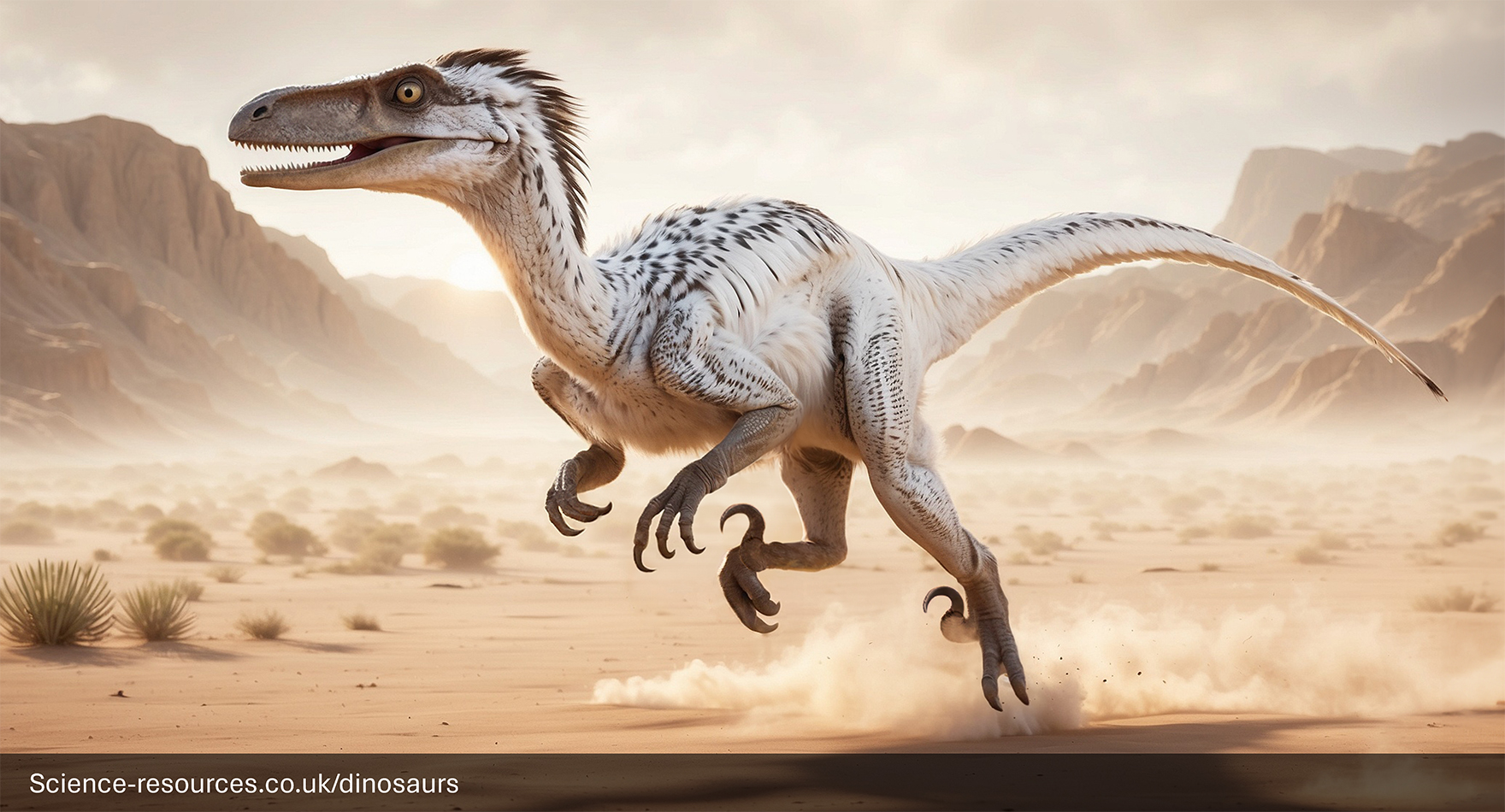Dinosaurs A:Z | U
You may also be intrested in: Free Dinosaur games
Dinosaurs: Utahraptor (Utah Robber)
You may also be intrested in: Free Dinosaur games
Utahraptor was a large meat-eating dinosaur that lived during the Early Cretaceous period, around 139 to 135 million years ago. It belonged to a group of dinosaurs known as Dromaeosaurids, which were small, intelligent hunters. Utahraptor was one of the biggest and oldest members of this group. • Length: Utahraptor could grow up to 7 meters (23 feet) long. • Height: They stood about 2.7 meters (8 feet) tall. • Weight: Utahraptor weighed around 1 ton (900 kg), about the same as a small car. Utahraptor had a stiff tail that helped it balance and make quick turns. It walked on two legs and had three-fingered hands with claws and four-toed feet with a large, sickle-like retractable claw on the second toe. This claw was its main weapon, used to slice into its prey.
Utahraptor Generative AI Notification: Some elements of this image have been created or enhanced using AI technology. To find out how we create all our dinosaurs, click here. While no fossilized feathers have been found with Utahraptor specimens, scientists believe it had feathers like other dromaeosaurids. This conclusion is based on the feathers found in related species and phylogenetic evidence. Utahraptor was a carnivore, which means it ate meat. It had rows of sharp, pointed teeth and hunted other animals, including large plant-eating dinosaurs like Hippodraco. Fossils of Utahraptor have been found in North America, particularly in areas that would have had a variety of environments to support the dinosaur's carnivorous diet. What is a Utahraptor?
How big was Utahraptor?
Appearance

Did Utahraptor have feathers?
What did Utahraptor eat?
Where did Utahraptor live?
Pronounced: YOO-tah-RAP-tor
• Utahraptor's name means "Utah Robber" because it was discovered in Utah. • It was one of the largest members of the Dromaeosaurid family, which also includes Velociraptor and Deinonychus. • Utahraptor may have hunted in packs, allowing it to take down prey much larger than itself. • The large brain of Utahraptor compared to its body size suggests it was very intelligent. Utahraptor was a swift dinosaur that moved on two legs. Its stiff tail helped it balance and make quick turns while chasing prey. The most unique feature of Utahraptor was its large, sickle-like claw on the second toe of each foot. This claw was controlled by a strong tendon and could be raised while moving and snapped down with great force when attacking prey. Utahraptor also had a very large brain, indicating high intelligence.


Utahraptor Facts
Name Means: "Utah Robber"
Length: 23 feet (7 m)
Height: 8 feet (2.7 m)
Weight: 1 tons (900 kilos)
Diet: Carnivore (Meat)
Time: Early Cretaceous
Fossils Found: Western North AmericaInteresting facts
How did Utahraptor move?
What were the unique features of Utahraptor?
Q1: What is a Utahraptor?
A1: Utahraptor was a large, carnivorous dinosaur that lived during the Early Cretaceous period, around 135 million years ago. It is known for its large size and sharp claws.
Q2: How big was the Utahraptor?
A2: Utahraptor could grow up to 7 meters (23 feet) long and weigh around 500 kilograms (1,100 pounds).
Q3: What did Utahraptor eat?
A3: Utahraptor was a carnivore, meaning it ate meat. It likely hunted large herbivorous dinosaurs and possibly scavenged for food.
Q4: How did Utahraptor move?
A4: Utahraptor was a fast and agile runner, moving on two legs. It had strong hind legs and a long tail for balance.
Q5: Where have Utahraptor fossils been found?
A5: Fossils of Utahraptor have been discovered in North America, particularly in the state of Utah.
Q6: What makes Utahraptor unique among dinosaurs?
A6: Utahraptor is unique because of its large, sickle-shaped claw on each hind foot, which it used to catch and hold onto prey. It is also one of the largest known dromaeosaurids.
Q7: How do scientists learn about Utahraptor?
A7: Scientists study fossils, including bones and sometimes footprints, to learn about Utahraptor. They also use modern technology like CT scans and computer models to understand how it moved and lived.
Q8: Did Utahraptor live alone or in groups?
A8: Evidence suggests that Utahraptor may have hunted in packs, similar to modern wolves, which would have made them more effective predators.
Q9: What new discoveries have been made about Utahraptor?
A9: Recent discoveries include a fossil block containing multiple Utahraptor individuals, providing new insights into their behavior and development.
Q10: Why is Utahraptor important to study?
A10: Studying Utahraptor helps scientists understand more about the behavior and evolution of predatory dinosaurs and their role in the ecosystems of the Early Cretaceous period.
Utahraptor FAQ
You may also be intrested in:
Tags: How big was Utahraptor, Utahraptor size, where does Utahraptor live, how tall are Utahraptor, what does Utahraptor mean, Utahraptor, Utahraptor facts